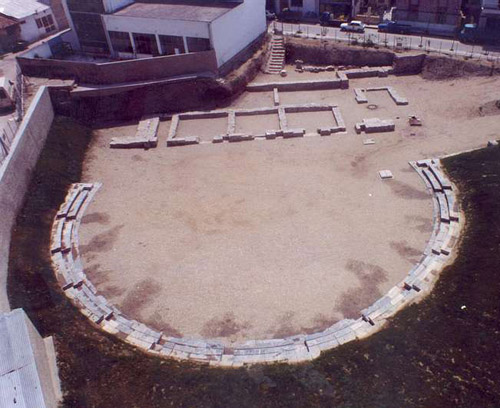
The Second Ancient Theatre of Larissa extends across the southwest slope of the low “Pefkakia” hill, at the junction of Ergatikis Protomagias and Tagmatarchou Velissariou Streets. A Christian church stood on the site, followed during the period of Turkish rule by the famous Hassan Bey Mosque depicted in various copperplate engravings. According to inscriptions, a Temple of Demeter stood on the “Pefkakia” hill where the theatre was founded.
The theatre was discovered by chance in 1978 and excavated systematically in 1985 and 1986, bringing the stage building, the orchestra, the cavea, the right parodos and part of the left parodos to light. It was built at the end of the 1st century BC, during the reign of Caesar Augustus.
The stage is 15.70 m. long in total and consists of three rooms. Its walls, preserved to a height of 0.60 m., are built of small rough stones and mud. The upper course was of raw brick. Behind the stage is a strong retaining wall, 50 m. long, built to hold back the earth of the slope. The orchestra has a diameter of 29.70 m. Its floor consists of two layers of river pebbles. On the right side was found a white marble stand, the stepped thymele (altar to Dionysos) of the theatre. South of the thymele, a cubic marble block was found in situ. It had tenons on its upper surface and was probably used as a statue base. The cavea had a total of 13 cunei (kerkides) with two tiers of marble seats in each, and 14 staircases. The remainder of the cavea was probably filled with wooden seats known as “ikria”. The material used for the cavea of the Second Ancient Theatre was not quarried but came from an earlier building of the 3rd c. BC. On one surface, the stones bear inscriptions commemorating the emancipation of slaves, which pre-existed in the older building and have nothing to do with the theatre. The inscriptions are dated to the late 3rd c. BC and are of great historical significance, as they are the oldest emancipatory inscriptions in Thessaly.
The Second Ancient Theatre was intended for both theatrical performances and other cultural events. It is very probable that, after the splendid First Theatre was turned into a Roman arena, it was also used for literary, dancing and musical competitions. This hypothesis is borne out by ancient inscriptions, which clearly state that, during the period of Roman rule in Thessaly, such competitions were held along with the horse races at the great Panthessalic festival of Larissa, the “Eleutheria” in honour of the Eleutherian Zeus.
Athanasios Tziafalias
Archaeologist
Ancient Theatre of Larissa II
Theatre
The theatre has the characteristic tripartite form of Hellenistic theatres: cavea, orchestra and stage building.
There are full photographical records and drawings.
1. Τζιαφάλιας Α, Αρχαιολογικές έρευνες στη Λάρισα. Πρακτικά του Συμποσίου «Λάρισα: Παρελθόν και Μέλλον» Λάρισα 1985, 56
2. Αρχαιολογία 34 (1990) 50.
3.Τζιαφάλιας Α. Δεκαπέντε χρόνια ανασκαφών στην αρχαία Λάρισα. Πρακτικά Διεθνούς Συνεδρίου, Λυών 1990, 153.
4. Les dossiers d’Archéologie 159 (1991) 50.
Junction of Ergatikis Protomagias and Tagmatarchou Velissariou Streets, in the city of Larissa.
–
The Second Ancient Theatre of Larissa extends across the southwest slope of the low “Pefkakia” hill, at the junction of Ergatikis Protomagias and Tagmatarchou Velissariou Streets. A Christian church stood on the site, followed during the period of Turkish rule by the famous Hassan Bey Mosque depicted in various copperplate engravings. According to inscriptions, a Temple of Demeter stood on the “Pefkakia” hill where the theatre was founded.
The theatre was discovered by chance in 1978 and excavated systematically in 1985 and 1986, bringing the stage building, the orchestra, the cavea, the right parodos and part of the left parodos to light. It was built at the end of the 1st century BC. The stage is 15,70 m. long in total and consists of three rooms. Its walls, preserved to a height of 0.60 m., are built of small rough stones and mud. The upper course was of raw brick. Behind the stage is a strong retaining wall, 50 m. long, built to hold back the earth of the slope. The orchestra has a diameter of 29.70 m. Its floor consists of two layers of river pebbles. On the right side was found a white marble stand, the stepped thymele (altar to Dionysos) of the theatre. South of the thymele, a cubic marble block was found in situ. It had tenons on its upper surface and was probably used as a statue base.
The cavea had a total of 13 cunei (kerkides) with two tiers of marble seats in each, and 14 staircases. The remainder of the cavea was probably filled with wooden seats known as “ikria”. The material used for the cavea of the Second Ancient Theatre was not quarried but came from an earlier building of the 3rd c. BC. On one surface, the stones bear inscriptions commemorating the emancipation of slaves, which pre-existed in the older building and have nothing to do with the theatre. The inscriptions are dated to the late 3rd c. BC and are of great historical significance, as they are the oldest emancipatory inscriptions in Thessaly.
39.64043°
22.411884°
| Name | Date | Amount (€) |
|---|---|---|
| Diazoma Association | 100.00 |
| Description | Budget | Target | Remarks |
|---|---|---|---|
| Short operations | 10.000.00 | 10.000.00 |